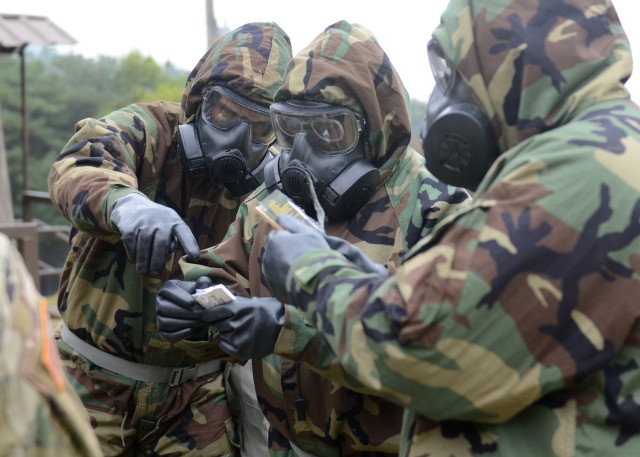CAMP CASEY, South Korea -- The 1st Armored Brigade Combat Team, 1st Infantry Division, hosted a chemical, biological, radiological and nuclear training course for incoming rotational Soldiers on Camp Casey Oct. 16.
The course, nicknamed the CBRN Academy, was a two-day course designed to teach designated leaders within the brigade how to protect themselves from CBRN attack as well as how to detect and identify hazardous substances.
The training was "pretty thorough," Sgt. Marcos Rodriguez, an armor crewman with 2nd Battalion, 34th Armor Regiment, 1st ABCT, 1st Inf. Div. said. "We were shown how to use the equipment properly which is something I've never done before, so it was pretty good."
The course took advantage of the knowledge and experience of CBRN experts from the 1st ABCT, 1st Cavalry Div. prior to handing over responsibility for the rotational mission in Korea.
"This is us communicating our lessons learned and hopefully they can take the headway that we've made and the level of training that we've brought our leaders up to and they can continue to build on that and excel," Capt. Katherine Snider, the CBRN officer in charge for 1st ABCT, 1st Cav. Div. said.
The course started with classroom instruction that included a country specific threat brief, followed by hands on training that culminated in a practical exercise where students donned protective masks and clothing and used chemical detection equipment in a range of scenarios.
"They showed us some new tools and how they work," 1st Lt. Devon Miller, a platoon leader with 1st Battalion, 16th Infantry Regiment, 1st ABCT, 1st Inf. Div. said. "They made it focus on our job set. We're going to be going in and we need to know how to identify what chemicals we're dealing with, to kit up if we get hit, how to continue to fight and when we're done, how to (decontaminate)."
For the Soldiers stationed in Korea, understanding counter weapons of mass destruction, or CWMD, operations is critical to their mission on the peninsula.
"We're in an area where chemical usage has a higher perceived likelihood of happening," Capt. Isaac Turner, the CBRN OIC for 1st ABCT, 1st Inf. Div. said. "Now people are actively paying attention and when they have a question, they're asking it rather than just staying quiet and checking the block to be done with training."
Now that the leaders have been trained, they will take what they have learned back to their units and train their Soldiers on how to properly identify and report CBRN incidents.






Social Sharing